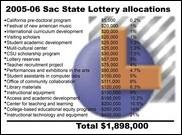You can bet on it

Jocelyn McGregor
February 20, 2007
Without the winning numbers, that Lottery ticket still isn’t a complete loss — at least 34 cents per dollar go to support public education.
It may not seem like much, but when tens of millions are at stake, Lottery tickets stack up quick.
Last year, Sacramento State was allotted nearly $1.9 million from Lottery funds, said Suzanne Green, associate vice president of Financial Services. An estimated $2.3 million is slated for this year.
According to the California Lottery website, half of the total generated sales goes back to player prizes, 34 percent goes to public education funds and the rest is spent recouping operation and commission costs.
Of the 34 percent, the California State University system receives about 3.5 percent of the education fund based on student population and attendance.
California Lottery spokesman Rob McAndrews said the Lottery fund is purely for supplemental purposes. After the money is distributed among the school systems, it’s up to the schools to decide what to do with it.
The money can be used for instructional purposes such as purchasing books and computers for a computer lab, McAndrews said. The money can’t be used to purchase real estate, as outlined in the Lottery Act of 1984.
“It’s to enhance students’ educational experiences,” said Donna Gillott Monsoor, budget analyst for the Provost’s Office.
After the funds are allotted to Sac State from the chancellor’s office, the sole power of distributing the money lies in the provost’s hands, Monsoor said.
According to the policy statements for Lottery budgeting and allocation process on the CSU website, the Lottery fund is not to replace general state funding. It also states that faculty, students and staff should be involved in developing expenditure plans for campus-based programs.
Sac State’s Lottery Fund Allocation Committee, which was composed of faculty, deans of colleges and students, was disbanded in 1998 by Jolene Koester, provost and vice president for academic affairs at the time.
Koester’s decision was met with protests from concerned faculty members because the change was not publicized throughout campus.
While the Lottery Fund Allocation Committee was never restored, current Provost and Vice President of Academic Affairs Joseph Sheley is very open to working with departments and colleges in the allocation process, Monsoor said.
“Because, while the amount we receive changes from year to year, based on Lottery money, some programs are pretty much run through lottery funds, there’s always reserve amount to spare,” Monsoor said. “So let’s say a program can really benefit from the Lottery fund or opportunity comes up within guidelines (in the Lottery Act of 1984 and CSU policy), there’s usually reserve that can go through special requests.”
Out of $1.9 million last year, $400,000 was spent for instructional technology and equipment, $260,000 for college-based educational equity programs and $200,000 for the Center for Teaching and Learning, an allocation report stated.
Monsoor said everything that was funded last year can count on being funded this year. Its usage for the estimated extra $600,000 still hasn’t been decided.
Pat Grady, interim director of the Multi-Cultural Center and director of Women’s Resource Center, said the $25,000 that the Multi-Cultural Center received last year has been helpful in funding speakers and presentations.
The Multi-Cultural Center, which sponsored the showing of the movie “Crash” and brought in Bobby Moresco, one of the screenwriters, for a lecture last spring, plans to bring in more speakers to educate students and bring up the issue of race in culture, Grady said.
Some projects that are still in the works include a James Baldwin play and a lecture by Elaine Brown, the first and only woman who was a president of the Black Panthers, Grady said. But to bring in well-known plays and people is expensive.
They can easily cost from $10,000 and up, she said.
While the lottery fund doesn’t work on a grant or request basis, Monsoor said faculty members and administrators have the opportunity to present ideas whenever it is seen that those funds could be put to good use with new projects or enhancing existing projects.
The ultimate decision is from the provost, but he maintains an open relationship with the campus, Monsoor said.




























































































































